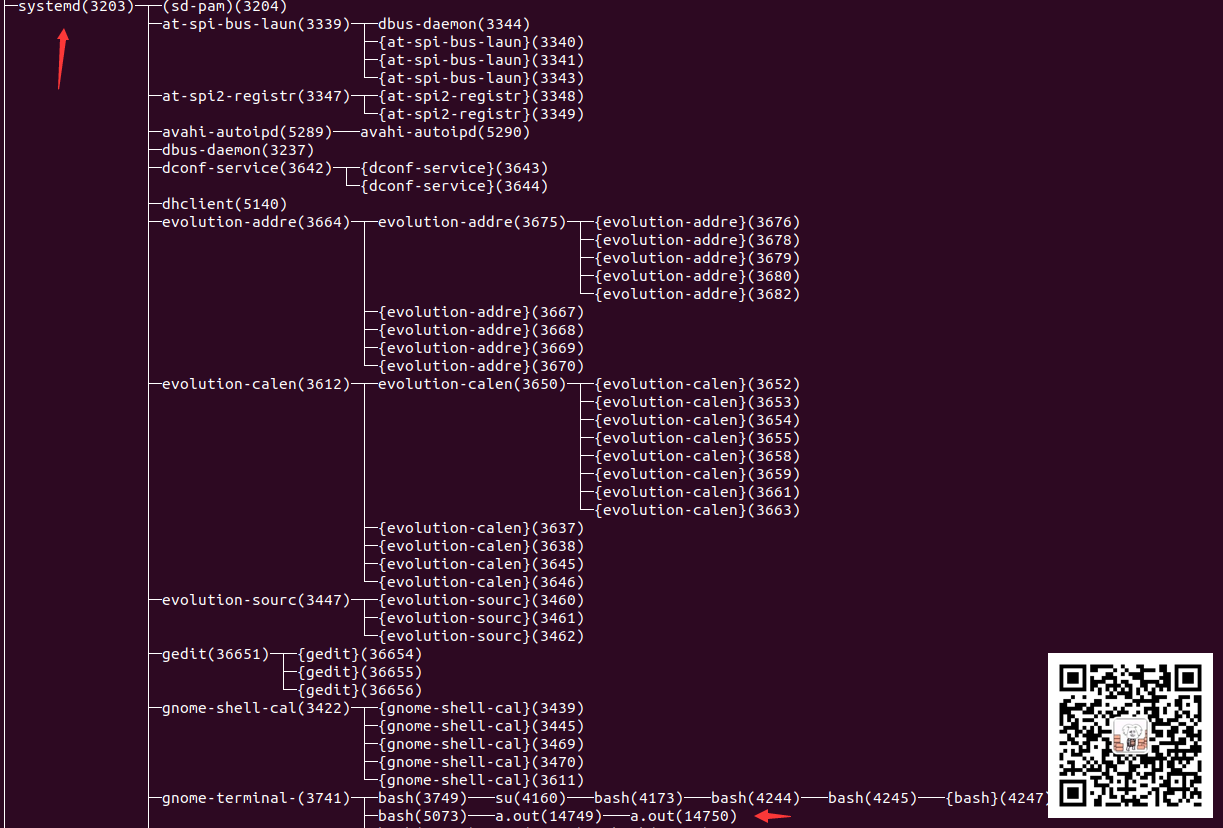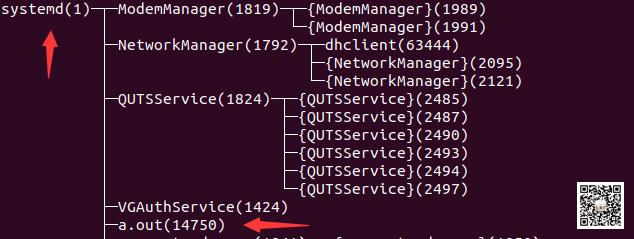PS:要转载请注明出处,本人版权所有。
PS: 这个只是基于《我自己》的理解,
如果和你的原则及想法相冲突,请谅解,勿喷。
环境说明
无
前言
由于某些其他的原因,我们在测试另外一个问题的时候发现了一个奇怪的现象:在我们一直朴素的认知下,如果一个程序创建了parent-process和child-process,这个时候,当child-process正在运行,parent-process退出的时候,child-process会被托孤到init进程。但是我们却通过pstree -p 发现了并不是这样的,他会被托孤到某一个特殊进程下面,这个特殊进程并不是init进程,而是init进程下面的某一个进程。下面是这个现象的验证过程:
测试程序
#include <unistd.h>
#include <sys/types.h>
#include <stdio.h>
int main(int argc, char * argv[])
{
int pid = fork();
if (pid < 0)
printf("fork failed.\n");
else if (pid > 0){
printf("parent : child pid = %d\n", pid);
}
else{
printf("child doing ... ...\n");
printf("first get ppid = %d\n", getppid());
sleep(20);
printf("second get ppid = %d\n", getppid());
sleep(1000);
}
sleep(15);
return 0;
}
我们运行这个程序后,其运行输出如下图:

我们对这个图进行分析,可以知道,当前的运行a.out进程pid是72140,然后子进程的pid是72141,在parent-process退出后,我们再次获取ppid,可以看到输出是3203。
接着我们看一下在parent-process未退出时的进程树图片节选:

在图中我们可以知道,我们的a.out在systemd(3203)->gnome-terminal-(3741)->bash(5073)->a.out(72140)
接着我们看一下在parent-process退出时的进程树图片节选:

在图中我们可以知道,当parent-process退出后,子进程72141被托孤给了systemd(3203),并不是我们熟知的pid为1的init进程。这里提前透露一下3203是systemd --user一个进程(同时也是一个subreaper)。
带着对这个问题的疑问,我查询了相关的资料,做了相关的实验,查询到这个现象的原因是PR_SET_CHILD_SUBREAPER相关导致的,因此有了本文的相关内容。
什么是Subreaper(PR_SET_CHILD_SUBREAPER) ?
对于这个问题,我们还是要去看man手册,链接如下:https://man7.org/linux/man-pages/man2/prctl.2.html
通过prctl函数,我们可以对当前进程做很多有趣的设置,其中一个就是PR_SET_CHILD_SUBREAPER选项,他主要是用来收集这些托孤进程的,一般是用来给一些守护进程管理进程(例如:上文提到的systemd)使用,使得一个进程能够管理自己的所有后代进程。其主要还是操作当前进程的task_struct中的is_child_subreaper属性,下面是实现的源码节选:
//kernel/sys.c
static int propagate_has_child_subreaper(struct task_struct *p, void *data)
{
/*
* If task has has_child_subreaper - all its descendants
* already have these flag too and new descendants will
* inherit it on fork, skip them.
*
* If we've found child_reaper - skip descendants in
* it's subtree as they will never get out pidns.
*/
if (p->signal->has_child_subreaper ||
is_child_reaper(task_pid(p)))
return 0;
p->signal->has_child_subreaper = 1;
return 1;
}
//kernel/sys.c
SYSCALL_DEFINE5(prctl, int, option, unsigned long, arg2, unsigned long, arg3,
unsigned long, arg4, unsigned long, arg5)
{
struct task_struct *me = current;
//...
switch (option){
//...
case PR_SET_CHILD_SUBREAPER:
me->signal->is_child_subreaper = !!arg2;
if (!arg2)
break;
//此函数遍历当前进程的所有子进程,并调用propagate_has_child_subreaper设置has_child_subreaper属性。
walk_process_tree(me, propagate_has_child_subreaper, NULL);
break;
case PR_GET_CHILD_SUBREAPER:
error = put_user(me->signal->is_child_subreaper,
(int __user *)arg2);
break;
//...
}
//...
}
通过如上的源码,我们可以知道了PR_SET_CHILD_SUBREAPER的实现部分原理,但是现在我们还是不知道为啥这样设置之后,当一个进程还有子进程时,当前进程退出后,子进程就托孤给了这个子进程收割者。这里可以提前透露一下,主要是和task_struct中的has_child_subreaper属性有关系。
当含有子进程的父进程退出时,怎么进行托孤的?
其实从问题就可以看出一点端倪,这个托孤的动作一般是发生在进程退出的时候,所以我们去找进程退出相关的代码应该能够找到一些启发。一般来说,我们的进程退出都会调用exit系统调用,对应到内核态,其实就是do_exit。我们通过has_child_subreaper来全局搜索,可以看到一些关联。下面是部分代码节选:
void __noreturn do_exit(long code)
{
struct task_struct *tsk = current;
int group_dead;
//...
exit_notify(tsk, group_dead);
//...
}
/*
* Send signals to all our closest relatives so that they know
* to properly mourn us..
*/
static void exit_notify(struct task_struct *tsk, int group_dead)
{
//...
LIST_HEAD(dead);
//...
forget_original_parent(tsk, &dead);
//...
}
/*
* This does two things:
*
* A. Make init inherit all the child processes
* B. Check to see if any process groups have become orphaned
* as a result of our exiting, and if they have any stopped
* jobs, send them a SIGHUP and then a SIGCONT. (POSIX 3.2.2.2)
*/
static void forget_original_parent(struct task_struct *father,
struct list_head *dead)
{
struct task_struct *p, *t, *reaper;
if (unlikely(!list_empty(&father->ptraced)))
exit_ptrace(father, dead);
/* Can drop and reacquire tasklist_lock */
//通过task_active_pid_ns()->child_reaper查找到一个reaper,然后返回出来,注意一般情况下这里查出来的进程就是当前namespace的init进程。
reaper = find_child_reaper(father, dead);
if (list_empty(&father->children))
return;
//根据init进程和has_child_subreaper属性,查询真正符合条件的reaper
reaper = find_new_reaper(father, reaper);
list_for_each_entry(p, &father->children, sibling) {//遍历当前退出进程的所有子进程
for_each_thread(p, t) {//遍历所有子进程的线程
RCU_INIT_POINTER(t->real_parent, reaper);//设置真正的父进程,这里的父进程就是上面我们查找出来了的满足要求的reaper
BUG_ON((!t->ptrace) != (rcu_access_pointer(t->parent) == father));
if (likely(!t->ptrace))
t->parent = t->real_parent;
if (t->pdeath_signal)
group_send_sig_info(t->pdeath_signal,
SEND_SIG_NOINFO, t,
PIDTYPE_TGID);
}
/*
* If this is a threaded reparent there is no need to
* notify anyone anything has happened.
*/
if (!same_thread_group(reaper, father))
reparent_leader(father, p, dead);
}
list_splice_tail_init(&father->children, &reaper->children);
}
在forget_original_parent中,我们可以看到整个方法的作用就是,找到一个reaper,然后将所有子进程交付给这个reaper。
我们怎么逃离PR_SET_CHILD_SUBREAPER的影响呢?
其实这个问题就在forget_original_parent中的find_new_reaper函数中,也就是has_child_subreaper这个属性怎么生效,下面我们来看看这个函数的功能:
/*
* When we die, we re-parent all our children, and try to:
* 1. give them to another thread in our thread group, if such a member exists
* 2. give it to the first ancestor process which prctl'd itself as a
* child_subreaper for its children (like a service manager)
* 3. give it to the init process (PID 1) in our pid namespace
*/
static struct task_struct *find_new_reaper(struct task_struct *father,
struct task_struct *child_reaper)
{
struct task_struct *thread, *reaper;
thread = find_alive_thread(father);
if (thread)
return thread;
if (father->signal->has_child_subreaper) {//注意has_child_subreaper属性生效的地方。
unsigned int ns_level = task_pid(father)->level;
/*
* Find the first ->is_child_subreaper ancestor in our pid_ns.
* We can't check reaper != child_reaper to ensure we do not
* cross the namespaces, the exiting parent could be injected
* by setns() + fork().
* We check pid->level, this is slightly more efficient than
* task_active_pid_ns(reaper) != task_active_pid_ns(father).
*/
for (reaper = father->real_parent;
task_pid(reaper)->level == ns_level;
reaper = reaper->real_parent) {
if (reaper == &init_task)
break;
if (!reaper->signal->is_child_subreaper)
continue;
thread = find_alive_thread(reaper);
if (thread)
return thread;
}
}
return child_reaper;
}
我们从find_new_reaper中可以知道,当has_child_subreaper有值时,我们就从当前进程的父进程开始查找,当找到一个进程的is_child_subreaper属性是有值时,我们就返回这个进程作为真正的reaper。当has_child_subreaper无值时,就是以init进程为reaper来托孤。
从以上的推理来看,我们有两个方案可以逃离PR_SET_CHILD_SUBREAPER影响:
- 直接改写真正PR_SET_CHILD_SUBREAPER的地方,不启用这个属性。例如修改systemd的源码。
- 写一个内核态的小工具,修改指定进程的as_child_subreaper的值,当我们禁用此值时,在进程退出时,就会把子进程托孤给init进程。
我们怎么逃离PR_SET_CHILD_SUBREAPER的影响呢?
按照上一个小结的结论,我们一般情况下是不会去改一些开源的系统程序,例如:systemd。因此我们选择直接写一个基本的内核态模块,直接修改其task_struct数据结构即可。ko文件如下:
#include <linux/module.h> /* Needed by all modules */
#include <linux/kernel.h> /* Needed for KERN_INFO */
#include <linux/pid.h>
#include <linux/sched.h>
#include <linux/sched/signal.h>
#include <linux/sched/mm.h>
#include <linux/mm_types.h>
#include <linux/rwsem.h>
#include <linux/slab.h>
#include <linux/fs.h>
#include <linux/mmap_lock.h>
#include <linux/pid_namespace.h>
MODULE_AUTHOR("sky <sky@sky.com>");
MODULE_DESCRIPTION("sky's hack");
MODULE_LICENSE("GPL");
MODULE_VERSION("1.0.0");
static int hack_pid = -1;
module_param_named(hack_pid, hack_pid, uint, S_IRUGO);
MODULE_PARM_DESC(hack_pid, "hack_pid");
int init_module(void)
{
printk(KERN_INFO "Hello sky_hack.\n");
printk(KERN_INFO "hack pid %d\n", hack_pid);
rcu_read_lock();
struct pid * _pid_struct = find_vpid(hack_pid);
if (NULL == _pid_struct){
printk("get pid struct failed.\n");
rcu_read_unlock();
return -1;
}
struct task_struct * _task_struct = get_pid_task(_pid_struct, PIDTYPE_PID);
if (NULL == _task_struct){
printk("get task struct failed.\n");
rcu_read_unlock();
return -1;
}
struct mm_struct * _mm_struct = get_task_mm(_task_struct);
if (NULL == _mm_struct){
printk("get mm struct failed.\n");
rcu_read_unlock();
return -1;
}
mmap_read_lock(_mm_struct);
if (_mm_struct->exe_file) {
char * pathname = kmalloc(PATH_MAX, GFP_ATOMIC);
if (pathname) {
char * p = d_path(&_mm_struct->exe_file->f_path, pathname, PATH_MAX);
/*Now you have the path name of exe in p*/
printk(KERN_INFO "process full path %s\n", p);
}
kfree(pathname);
}
mmap_read_unlock(_mm_struct);
struct pid_namespace *pid_ns = task_active_pid_ns(_task_struct);
struct task_struct *reaper = pid_ns->child_reaper;
printk(KERN_INFO "pid_ns->child_reaper=%x, current task_struct=%x\n", pid_ns->child_reaper, _task_struct);
printk(KERN_INFO "is_child_subreaper %d\n", _task_struct->signal->is_child_subreaper);
printk(KERN_INFO "has_child_subreaper %d\n", _task_struct->signal->has_child_subreaper);
//escape from a subreaper by do_exit()
_task_struct->signal->has_child_subreaper = 0;
rcu_read_unlock();
return 0;
}
void cleanup_module(void)
{
printk(KERN_INFO "Goodbye sky_hack.\n");
}
当前这个驱动的唯一目的就是把指定pid进程的has_child_subreaper改为0,这样就可以逃离subreaper。
编译Makefile
obj-m += sky_hack.o
all:
make -C /lib/modules/$(shell uname -r)/build M=$(PWD) modules
clean:
make -C /lib/modules/$(shell uname -r)/build M=$(PWD) clean
下面我们再一次做上面的测试,运行a.out,查看a.out相关的进程树,然后运行sky_hack.ko hack_pid=‘a.out进程id’,等待一段时间后,当a.out退出后,再次查看a.out的相关进程树即可。
运行a.out的输出:

我们其实可以看到,按照上面我们的说明进行操作后,a.out第二次打印的ppid已经是1了,这意味着我们逃离subreaper成功了。
下面我们看看insmod sky_hack.ko hack_pid=14749的输出:

我们其实可以看到,在驱动里面我们打印了a.out进程的has_child_subreaper属性是1,因此我们在驱动中重置了它,导致了退出时,成功托孤给了init进程。
下面我们看看这整个阶段中的进程树状况:

这里的进程分布和上述开始的一样。
我们看看逃离subreaper后:

这里的进程分布就和最开始的不一样的,我们成功的将我们的子进程托孤给了init进程。
后记
我们首先从一个其他问题,遇到了这个现象,然后我们深究了这个现象产生的原因,并且最终尝试设计出逃离这种现象的技术方案。这其中会涉及一些内核源码,驱动编写,同时加深了我们对subreaper的理解。经过这些过程后,我们对Linux内核,Linux的应用开发会有一个新的认知和理解。同时也增强了我们解决问题的综合能力。
参考文献
- 无

PS: 请尊重原创,不喜勿喷。
PS: 要转载请注明出处,本人版权所有。
PS: 有问题请留言,看到后我会第一时间回复。